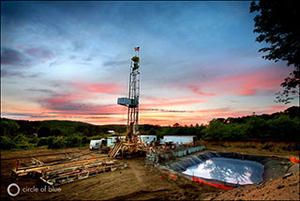EnergyWater shortage hobbles expansion of shale gas drilling
Many point to the large reserves of shale gas as promising U.S. energy independence in the near future. Extracting shale gas, however, requires huge amounts of water, and growing water shortages have already led to conflicts over water use between shale gas developers and farmers. Such conflicts are only going to intensify.

Shale gas drilling uses large amounts of water // Source: umich.edu
Demand for electricity in the United States is expected to increase by 1.5 percent over the next two decades. Government agencies and businesses are promoting conservation efforts and technological advances to reduce the need for water by utility and energy firms.
EnergyBiz reports that in Texas, a combination of high temperatures and water shortages have caused a feud between farmers and shale gas developers as both are fighting for limited water supply.
“Freshwater resources around the world are under threat from fossil fuel development, and these threats are emerging in new places with rapid growth in recent years of natural gas extraction from shale using horizontal drilling and hydraulic fracturing,” Downstream Strategies of Morgantown, West Virginia reports. “This technique has been criticized for its environmental impacts, including dewatering streams and surface-and-groundwater pollution.”
EnergyBiznotes that within the Marcellus Shale region, which straddles Pennsylvania and West Virginia, 4.1 million to 5.6 million gallons of fresh water are used per fractured well – and there are 9,000 wells in the area.
World Policy Institute (WPI) reports that natural gas produced via hydraulic fracturing consumes seven times more water than conventional gas extraction, but roughly the same amount of water as conventional oil drilling.
About 30 percent of America’s electricity derived from natural gas, a 7 percent increase from ten years ago according to the U.S. Energy Information Administration. Shale gas makes up 25 percent of that. An increase in the use of natural gas will lead to increase water shortages in states which permit shale gas operations. WPI reports that among conventional power plants, gas-fired plants consume the least amount of water per unit of energy produced. Coal- and oil-fired plants consume roughly twice as much water as gas-fired plants. Nuclear consumes approximately three times as much. Wind and solar photovoltaic electricity consume minimal water and are the most water-efficient forms of conventional or alternative electricity production.
Water shortages will affect every aspect of society and the expected increase in shale gas operations will require more water. Downstream Strategies advises that “the true scale of water impacts can still only be estimated, and considerable improvements in industry reporting, data collection and sharing, and regulatory enforcement are needed.”
Diversification of energy resources and adoption of newer technologies which allow preservation are necessary, even if the threat of water shortage is often dismissed.
